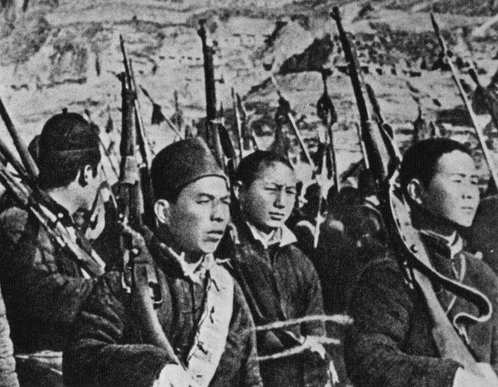Chinese Civil War (1927-1950): Background, Key Phases and consequences
The Chinese Civil War had its roots in the broader political and social upheaval that plagued China in the early 20th century.
The collapse of the Qing Dynasty in 1911 and the subsequent establishment of the Republic of China under Sun Yat-sen marked the end of imperial rule but did not bring stability.
2. Major Factions:Chinese Nationalist Party (Kuomintang or KMT): Led by Chiang Kai-shek (Jiang Jieshi), the KMT aimed to unify China under a single, nationalist government.
Chinese Communist Party (CCP): Led by Mao Zedong, the CCP sought to establish a communist state in China.
3. Key Phases:First United Front (1927-1928): Initially, the KMT and CCP formed an alliance against warlords and foreign imperialism. However, the alliance quickly deteriorated, leading to the Shanghai Massacre of 1927, in which KMT forces purged communists from their ranks.
The Long March (1934-1935): After a series of setbacks, the CCP embarked on the Long March, a grueling retreat to evade KMT forces. This event solidified Mao Zedong's leadership within the CCP.
Second United Front (1937-1945): The outbreak of the Second Sino-Japanese War (1937-1945) forced the KMT and CCP to unite against Japanese aggression.
Resumption of Civil War (1945-1949): After World War II and Japan's defeat, hostilities between the KMT and CCP resumed. The CCP gradually gained the upper hand.
4. Major Battles:Notable battles included the Battle of Pingjin, the Huaihai Campaign, and the Battle of Huaiyin-Huai'an.
5. Foreign Involvement:While foreign powers, including the Soviet Union and the United States, had varying degrees of influence and support for the KMT and CCP, the Chinese Civil War was primarily an internal struggle.
6. Victory of the CCP:The CCP achieved victory on October 1, 1949, when Mao Zedong declared the establishment of the People's Republic of China in Beijing.
Chiang Kai-shek and the KMT retreated to Taiwan, where they continued to govern the Republic of China.
7. Consequences:The Chinese Civil War resulted in a divided China, with the PRC governing the mainland and the ROC (Taiwan) maintaining control over the island.
The conflict had a profound impact on Chinese society and politics, leading to extensive social and economic reforms under communist rule.
It also marked a shift in China's foreign policy and its relations with the Soviet Union and the United States.
The Chinese Civil War was a protracted and complex conflict that reshaped the political landscape of China and had far-reaching implications for the 20th century. It led to the establishment of the People's Republic of China under communist rule, which continues to govern mainland China to this day, while Taiwan remains under the control of the Republic of China.
The collapse of the Qing Dynasty in 1911 and the subsequent establishment of the Republic of China under Sun Yat-sen marked the end of imperial rule but did not bring stability.
2. Major Factions:Chinese Nationalist Party (Kuomintang or KMT): Led by Chiang Kai-shek (Jiang Jieshi), the KMT aimed to unify China under a single, nationalist government.
Chinese Communist Party (CCP): Led by Mao Zedong, the CCP sought to establish a communist state in China.
3. Key Phases:First United Front (1927-1928): Initially, the KMT and CCP formed an alliance against warlords and foreign imperialism. However, the alliance quickly deteriorated, leading to the Shanghai Massacre of 1927, in which KMT forces purged communists from their ranks.
The Long March (1934-1935): After a series of setbacks, the CCP embarked on the Long March, a grueling retreat to evade KMT forces. This event solidified Mao Zedong's leadership within the CCP.
Second United Front (1937-1945): The outbreak of the Second Sino-Japanese War (1937-1945) forced the KMT and CCP to unite against Japanese aggression.
Resumption of Civil War (1945-1949): After World War II and Japan's defeat, hostilities between the KMT and CCP resumed. The CCP gradually gained the upper hand.
4. Major Battles:Notable battles included the Battle of Pingjin, the Huaihai Campaign, and the Battle of Huaiyin-Huai'an.
5. Foreign Involvement:While foreign powers, including the Soviet Union and the United States, had varying degrees of influence and support for the KMT and CCP, the Chinese Civil War was primarily an internal struggle.
6. Victory of the CCP:The CCP achieved victory on October 1, 1949, when Mao Zedong declared the establishment of the People's Republic of China in Beijing.
Chiang Kai-shek and the KMT retreated to Taiwan, where they continued to govern the Republic of China.
7. Consequences:The Chinese Civil War resulted in a divided China, with the PRC governing the mainland and the ROC (Taiwan) maintaining control over the island.
The conflict had a profound impact on Chinese society and politics, leading to extensive social and economic reforms under communist rule.
It also marked a shift in China's foreign policy and its relations with the Soviet Union and the United States.
The Chinese Civil War was a protracted and complex conflict that reshaped the political landscape of China and had far-reaching implications for the 20th century. It led to the establishment of the People's Republic of China under communist rule, which continues to govern mainland China to this day, while Taiwan remains under the control of the Republic of China.



Comments
Post a Comment